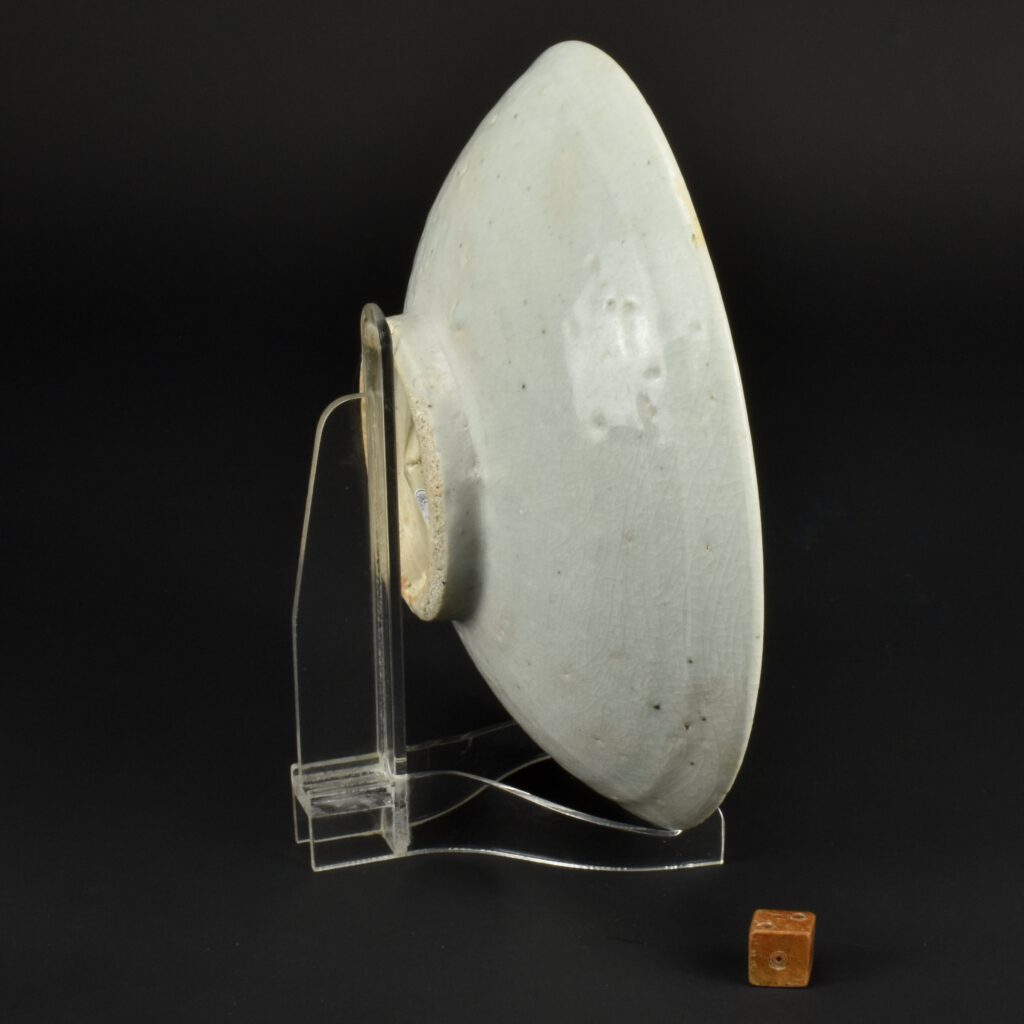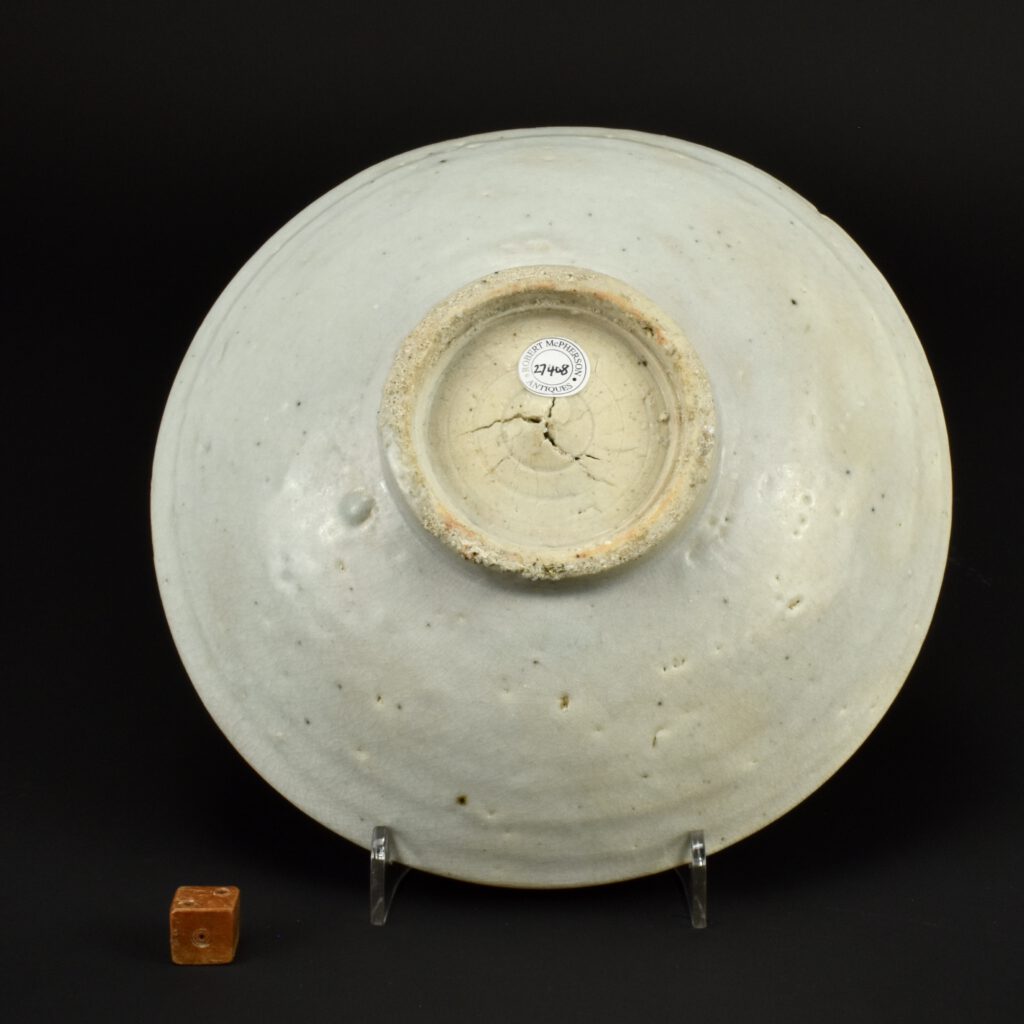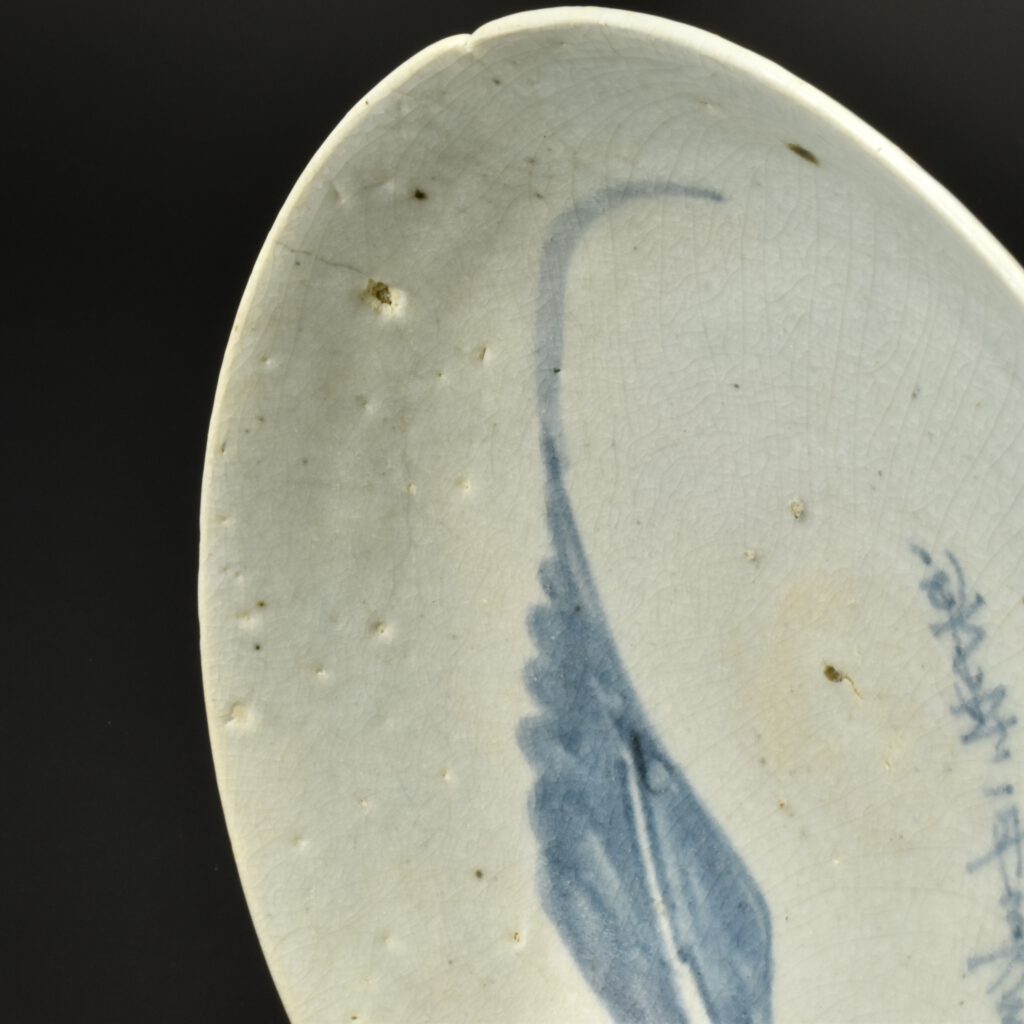
A Rare Japanese Shoki-Imari blue and White Porcelain Leaf and Poem Bowl.
A Rare Japanese Shoki-Imari Blue and White Porcelain Leaf and Poem Bowl, Arita Kilns c.1610 – 1640. This rare bowl is of a design that is found on Chinese Transitional porcelain from the Shuzhi period (1644-1661) and early Kangxi period (1662-1674). The later Chinese porcelains ones are often much more sophisticated that the present early Japanese porcelain example. They often have a poem within the leaf, the writing was made using wax resist, so the calligraphy appears white against the blue leaf. The present Shoki-Imari bowl seems to predate the Chinese examples. The painting is very quickly applied, the leaf is just a sketch using cobalt that has fired blue-grey. The porcelain is low-fired and dull sounding when tapped. The body is porous, the glaze has firing faults, including an indentation when a piece of grit came loose, there are lots of bubbles to the glaze and a large iron-spot. This, together with the shape of the footrim, is typical of some of the earliest Japanese blue and white porcelain referred to as Shoki-Imari.
The Poem : ‘幽赏未已高谈转清’ is a beautifully crafted piantiwen 骈体文 (parallel prose) from Li Bai’s Spring Night Banquet in Peach Blossom Garden with My cousins.春夜宴从弟桃李园序.作者:李白 “幽赏未已” (The serene appreciation lingers): This line evokes an immersive enjoyment of nature’s beauty, with the word “幽” highlighting the tranquil and secluded ambiance of the Peach Blossom Garden. It reflects the Tang literati’s aesthetic ideals of nature and reclusion. “高谈转清” (Lofty discussions turn clearer): This describes the refined and elevated conversations of the gathering. The term “高谈” suggests intellectual and lofty discussions, while “转清” conveys a progressive clarity and purity in thought, symbolising a spiritual elevation. The lines are presented in perfect parallelism, with a rhythmic balance between “幽” and “高,” “赏” and “谈,” and “未已” and “转清.” This harmony underscores the stylistic richness and formal elegance typical of piantiwen. (Many thanks to Mr Tom Oxley for translating this poem).
See Below For More Photographs and Information.
SOLD
- Condition
- There are three firing cracks to the rim, the central firing crack comes from an indentation made by a piece of grit coming out, this firing crack can be seen from the back. The firing crack at the top of the bowl comes from a firing fault (dent to the rim prior to firing).
- Size
- Diameter 17.6 cm (6.9 inches). Depth 5.3 cm (2.1 inches)
- Provenance
- N/A
- Stock number
- 27408
- References
- For two dishes of this type dated to the Shuzhi period (1644-1661) see : Leaping The Dragon Gate, The Sir Michael Butler Collection of Seventeenth Century Chinese Porcelain (Teresa Camepa and Katherine Butler, Ad ILissvm. 2021. ISBN 978-1-912168-16-3) Page 292, III.4.34. For a similar slightly later version, Kangxi blue and white porcelain dish dated 1667, from the Butler Family Collection (collection number F22) see : Seventeenth Century Jingdezhen Porcelain from the Shanghai Museum and the Butler Collection.
Information
Chinese Leaf and Poem Dishes From Robert McPherson Antiques.
A Related, But Later Dated Transitional Dish, Early Kangxi Period 1667.
R & G McPHERSON ANTIQUES ‘SUMMER EXHIBITION’
Including Chinese and Japanese Ceramics from The John Drew Collection Part II.
KANGXI 1667
A Rare Dated Early Kangxi Blue and White Porcelain Dish in the Chinese Taste, 1667.
The base dated 1667, the poem next to the leaf on the front reads ‘When this leaf falls everyone knows the autumn season is coming’.
For a very similar Kangxi blue and white porcelain dish also dated 1667 from the Butler Family Collection (collection number F22) see : Seventeenth Century Jingdezhen Porcelain from the Shanghai Museum and the Butler Collection (Shanghi Museum,2006. ISBN 1-85759-417-7) page 35 fig 6 ; We would like to thank Mr S. Balmer for drawing our attention to this reference.
Provenance :
S.Marchant & Son.

A Similar Cruder Transitional Porcelain Dish
R&G McPherson Antiques

A 17th Century Chinese Blue and White Porcelain Saucer Shaped Dish, Shunzhi or Early Kangxi c.1650 – 1670, Jingdezhen Kilns.
Robert McPherson Antiques - Sold Archive - 25757

Condition
One small rim chip. Some unevenness to the rim.
Size
Diameter : 19.9 cm (8 inches)
Stock number
25757
References
For two dishes of this type dated to the Shuzhi period (1644-1661) see : Leaping The Dragon Gate, The Sir Michael Butler Collection of Seventeenth Century Chinese Porcelain (Teresa Camepa and Katherine Butler, Ad ILissvm. 2021. ISBN 978-1-912168-16-3) Page 287, III.3.34 and III.3.35. For a similar slightly later version, Kangxi blue and white porcelain dish dated 1667, from the Butler Family Collection (collection number F22) see : Seventeenth Century Jingdezhen Porcelain from the Shanghai Museum and the Butler Collection.
Two Shunzhi Porcelain Leaf and Rock Dishes.
Robert McPherson Antiques - 25769 and 25680A.















